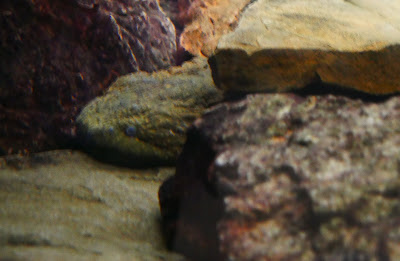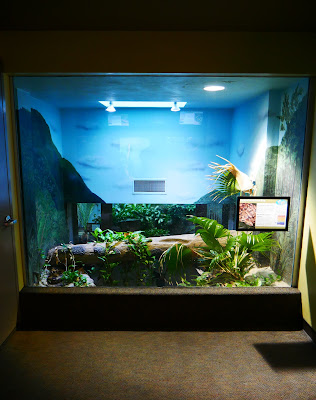I have seen my fair share of Herpetariums in my adventures zoo-hopping. Among the best I've encountered, I would include the: Philadelphia Zoo, Virginia Zoo, Smithsonian National Zoo, and Toledo Zoo. The St. Louis Zoo's Herpetarium shoots to the top! Not by miles, but by appreciable degrees. What I liked most:
1) The straightforward layout of the building's interior, easy to follow, designed with a balance of uniformity and highlights.
2) The size of the habitats. Exceptional in the world of Herpetariums--no small, "aquarium"-sized digs for any of the animals.
3) LIVE PLANTS! Hallelujah! Putting any creature in a space without living, real, even edible flora, is a sin. If they eat the damned plant, you just replace it when they're not looking!
4) The nod to the building's heritage with amazing original architectural elements balanced against modern, clean habitats with amazing sight-lines and photographable access.
5) Variety of Species! Holy Cow! Along with a handful of faithful regulars (Aruba Island Rattlesnake, Gila Monster, etc.) was a plethora of never before seen wonders! Especially from central Asia. Every time I read a placard, my knees went weak.
So I know this is excessive. And If Reptiles/Amphibians are not your thing, or even freak you out, please feel free to bypass this post. Cause this is me at my Geeked-out finest!
You enter and immediately encounter this stunning atrium--the same thing is true for the Small Primate House, and the Tropical Bird House. All three built with the same exterior design at roughly the same time back in the 1920's.
Here you get a really great look at how the old and the new integrate.
On either side of the entrance off the front wall are two humongous habitats. This one is stage right. It's home to Gila Monster lizards. By a factor of...oh, I dunno 10, 20!--it's the largest one I've ever seen. Can you see the little guy against the glass on the lower right side?
A second beauty was found resting among the faux rock formation behind the first.
ARUBA ISLAND RATTLESNAKE
Found in many zoos, it's still a unique snake from a little island in the Caribbean.
Another humongous habitat, this one for the Black Mamba--give it some props! This little bubby is a lethal killer in Africa, and the chief villain in one of my favorite books: "The Poisonwood Bible" by Barbara Kingsolver.
BLACK MAMBA
ARIZONA RIDGE-NOSED SNAKE
BLACK-TAILED HORNED VIPER
TAMAULIPAN ROCK RATTLESNAKE
The Tamaulipan Rock Rattlesnake is native to deserts in southwestern U.S. and Northern Mexico. And here's the really cool thing: it's venom is targeted at invertebrates. Not that it won't make a spined-animal sick, it's just very unlikely to incapacitate or kill it. Isn't that amazing?
EASTERN MASSASSAUGA
One of the many programs the St. Louis Zoo spearheads in the realm of Species Survival is in behalf of the Ozark Hellbender. One of the largest salamanders in the world, it is critically endangered. This habitat includes both it and a turtle species and tells the story of how the St. Louis Zoo has bred and returned to the wild over 10,000! Now, that a fucking big deal.
The "rock" with the eye is an Ozark Hellbender.
This Northern Map Turtle shares the stream in the habitat with the Ozark Hellbenders.
BLACK-BREASTED LEAF TURTLE
TOKAREN PIT VIPER
On the opposite side of the entrance from the Gila Monsters (stage left) is this mirror habitat designed to house Jamaican Iguanas. Can you see him?
Here he is in close-up.
And here's a second...I'm pretty sure there are more than two.
MANGSHAN VIPER
Before visiting the Memphis Zoo earlier in the week, I'd never even heard of this species. Then I saw it again at the Little Rock Zoo. And now here at the St. Louis Zoo. It's become one of my favorite serpents. Along with the Corn Snake and the Gaboon Viper--it's just so damned colorful and unique.
PREHENSILE-TAILED SKINK
I love these critters in a special way. They are so beautiful and have such expressive faces.
McCORD'S BOX TURTLE
A super endangered gem from Indochina.
KIKO POISON DART FROG
Can you see him? PD Frogs are so small.
I have seen and am intimately familiar with about 12 species of Poison Dart Frogs, but I have never seen this one before--and it's the only one they offer to public viewing.
At one turn, I encountered this shelf display of awards and various artifacts from years of research and field study of Reptiles and Amphibians. I love this anecdotal artifact stuff, too.
One detail: Anti-venom! What a good idea, no?
On the far side of the main building, I encountered these habitats that were two stories tall with one side in the original building and the other visible to the floor below in the addition.
This one was home to a Central American Boa who was sleeping on a ledge behind the faux log, and only visible from this level.
The same habitat from down below. This one has a water feature with cichlids swimming in it.
SOUTHERN CANTIL
LAKE TITICACA FROG
An example of the excellent signage found throughout the St. Louis Zoo.
Back to the original atrium, I also want to show off some of the original detailing.
RIO PESCADO STUBFOOT TOAD
Long thought extinct, this beautiful amphibian was rediscovered in a tiny valley in Ecuador, and now is part of a Species Survival Program spearheaded at the St. Louis Zoo. The balance between existence and extinction is often a thin line and more and more species are depending upon zoos and institutions like zoos just to simply continue to BE.
The newer lower level has a series of large habitats on one side that connect like the Central American Boa's to the upper level, and then a large open habitat on the opposite side divided into three zones.
The middle zone is the winter home to three species of large land tortoises: Aldabra, Galapagos Island, and Sulcata.
A beautiful Sulcata Tortoise.









































No comments:
Post a Comment